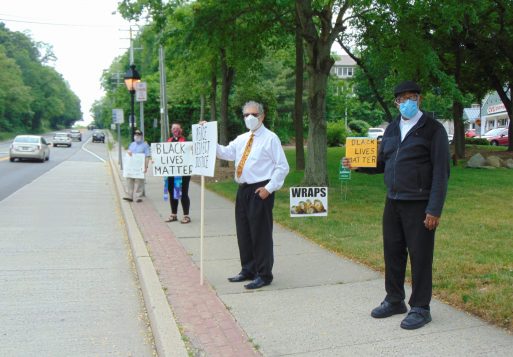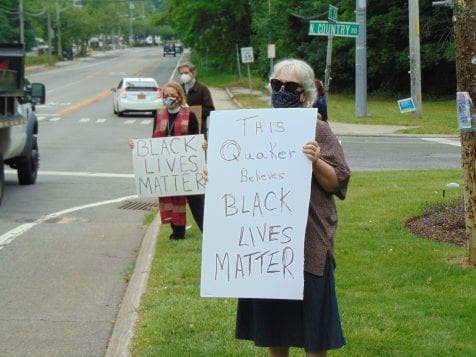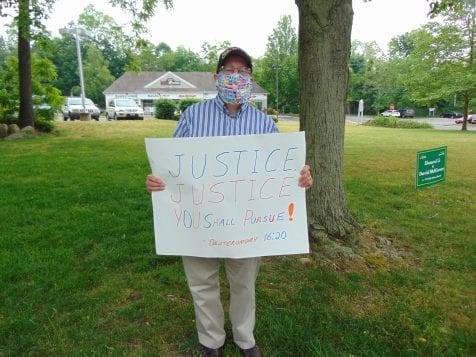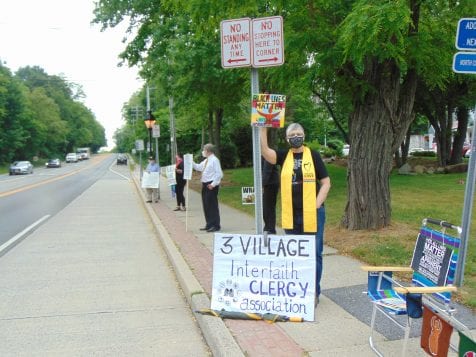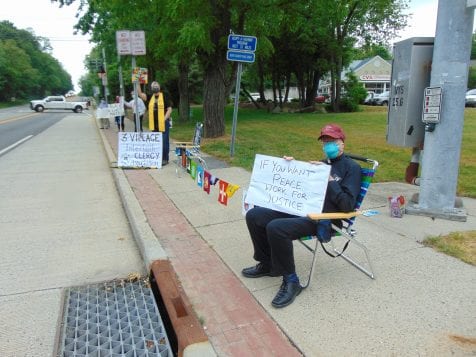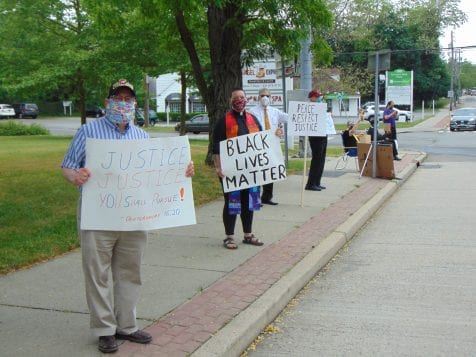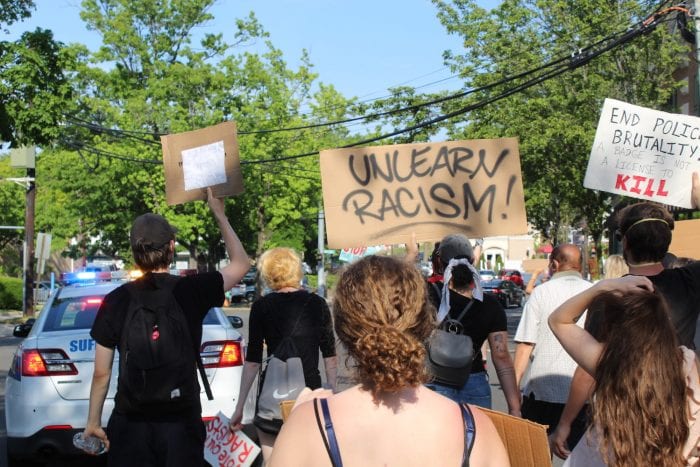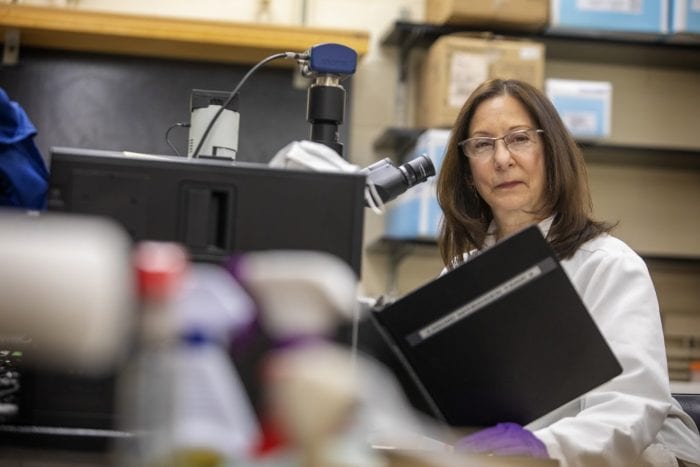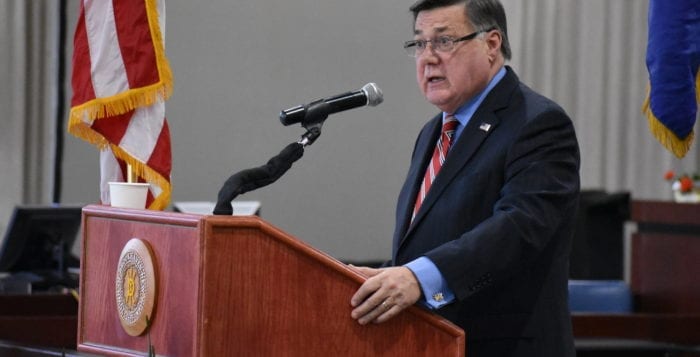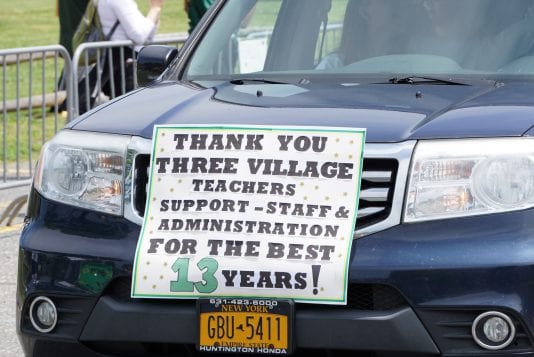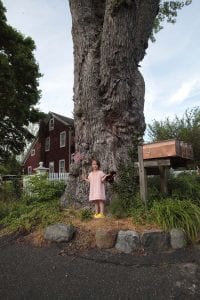Approximately a dozen clergy members stood for equality at a Setauket intersection June 5.
Members of the Three Village Interfaith Clergy Association gathered on the southeast and northeast corners of Route 25A and Bennetts Road/North Country Road. On the muggy Friday, with signs in hand, the peaceful protesters wanted to let the community know that black lives matter. The protest was in response to the death of George Floyd in Minneapolis at the hands of a police officer.
The Rev. Linda Anderson, community minister in affiliation with the Unitarian Universalist Fellowship at Stony Brook, said it was important to organize the event with faithful people from different religions.
“We wanted to show people that we can stand together for peace and for justice, and that is what our faiths ask us,” she said.
The Rev. Gregory Leonard, of Setauket’s Bethel African Methodist Episcopal Church and one of the founding members of the grassroots organization Building Bridges in Brookhaven, said when it comes to residents caring about an issue, it starts with the faith communities. The pastor said at this significant moment in history, the group couldn’t let it pass by without doing something.
“This is a big moment,” he said. “Something is happening, and it could be something good if we stand up and speak up, and it could be something negative if we just sit there and don’t say anything.”
Rabbi Paul Sidlofsky, from Temple Isaiah in Stony Brook, said the individual congregations have been emphasizing the importance of human rights, but he said it was important to come together as a community.
“This is not something that affects one group, one religion or one part of our society, but it affects everyone — everyone who believes in freedom, who believes in justice and equal rights,” he said.
Elaine Learnard, a Quaker and member of Conscience Bay Friends Meeting, said it was important for her to take part.
“Quakers, since the beginning, have believed in equality of all, and like most of the nation, we haven’t always lived up to our ideals, and it’s important,” she said. “This is a time to me of crisis with potential for great change, and it’s important to be heard and seen in support of the equality of all.”
The majority of the drivers passing by were honking and giving nods of approval.
“I think our signs saying who we are, Three Village Interfaith Clergy Association, I think that helps people have goodwill and maybe make some of them think a little bit,” Anderson said.
Leonard was not surprised.
“I have always known here in the Three Village there are more compassionate, good people than there are those who are afraid and negative,” he said.
Though Leonard did notice a few negative gestures that didn’t deter his hope in people.
“You know what, it’s the start of a dialogue, talking to each other,” he said. “When we talk to each other, get to know one another then hopefully things like what happened with George Floyd will become less and less. I think there will always be hatred and ignorance in the world. I think that’s just the way it is, but today the Three Village clergy and the other people who have joined us are making a statement that what’s going on is not right. We need to respect each other. We need to get to know one another. We need to build bridges to one another.”
Sidlofsky said the negative is expected as sometimes people misinterpret the message.
“We have to realize that when we stand up for the rights of one group such as the African American community, it doesn’t mean you’re denying the rights of others, it means you’re enhancing human rights,” he said.
Anderson said she has faith in the future.
“I always have faith and trust in the goodness that’s in humanity and I think, I hope, that we perhaps have hit a bottom and the only place to go is up,” she said.
The Rev. Ashley McFaul-Erwin, community outreach pastor for Setauket Presbyterian Church, who grew up in Northern Ireland, is also hopeful.
“I really believe in the inherent goodness in all people,” she said, adding it will take hard work to continue building relationships. “I think at the heart of it, even though we’re very divided right now, there’s a goodness that I hope will come through.”
Leonard said, regarding Floyd’s death, the thing that sticks with him most is how he cried out for his mother who died two years earlier.
“When he called out for his mother, he called out for all mothers black and white, rich and poor,” the pastor said. “That was very meaningful for me and something to think about regarding the tragedy of his death.”

